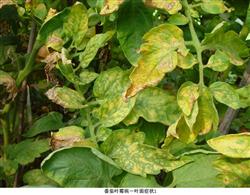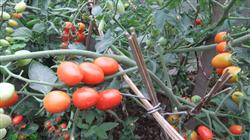Continuous coring and pruning of small tomato

Tomato is a creeping crop, but it is often cultivated vertically by introducing frame in cultivation. Therefore, with the growth and extension of the plant, the farther away from the ground, the effect of flowering, fruit setting and fruit expansion is less ideal, and the yield can not be increased. In view of this bad situation, the continuous coring method can be used to increase the weight of the first ear and the number of flowers, so as to achieve the purpose of increasing production. The method is as follows: using the form of single stem pruning, retaining the first and second inflorescences, and then leaving 2 leaves above the second inflorescence to pick the heart. Let the lateral buds under the first inflorescence continue to grow as the main branch, and then leave 2 leaves above the fourth inflorescence to pick the heart, so that the lateral buds under the third inflorescence continue to grow as the main branch. The operation was repeated several times (the number of operations was determined according to soil fertility and plant growth). This operation method has lower plants, which is beneficial to the supply of fertilizer and water, and has earlier maturity and higher yield.
- Prev

Control methods of cherry tomato leaf mold
Growing cherry tomatoes in greenhouse is often attacked by leaf mold, so vegetable farmers should pay attention to prevention and control. First, the symptoms mainly harm the leaves, and in severe cases, they also harm the stems, flowers and fruits. The leaves are infected with irregular or oval yellowish chlorotic spots on the leaf surface, the primary white mold layer in the leaf back disease, and the mold layer becomes grayish brown or grayish brown in the later stage.
- Next

Early planting techniques of Virgin Tomato in Spring
Virgin tomato, native to Taiwan, is a kind of cherry tomato, mainly to eat fresh fruit, to be called virgin fruit. Early cultivation in spring, you can use a plastic greenhouse with a span of 6 meters, raise seedlings in the middle of November, plant in February of the following year, harvest fresh fruit in early May, and produce 6000 kg of fresh fruit per mu. First, seed treatment. ...
Related
- Moge, come on! The staff of the peasant association in the producing area of cantaloupe were frightened when the crowd gathered.
- Causes and Solutions of low Fruit setting rate of Apple
- Symptoms and control measures of passion fruit virus disease
- Fruit growing lesson: how do apple orchards keep high yields?
- Can you build orchards in the mountains? What are the pros and cons?
- How to manage the coloring period of Crisson grape?
- This paper introduces the processing technology of two kinds of fig products.
- How much is a month for retired teachers in rural areas by 2020?
- How can strawberry planting increase sugar content? We should pay attention to management in many aspects.
- What are the cultivation techniques on how to improve the yield of golden fruit?

